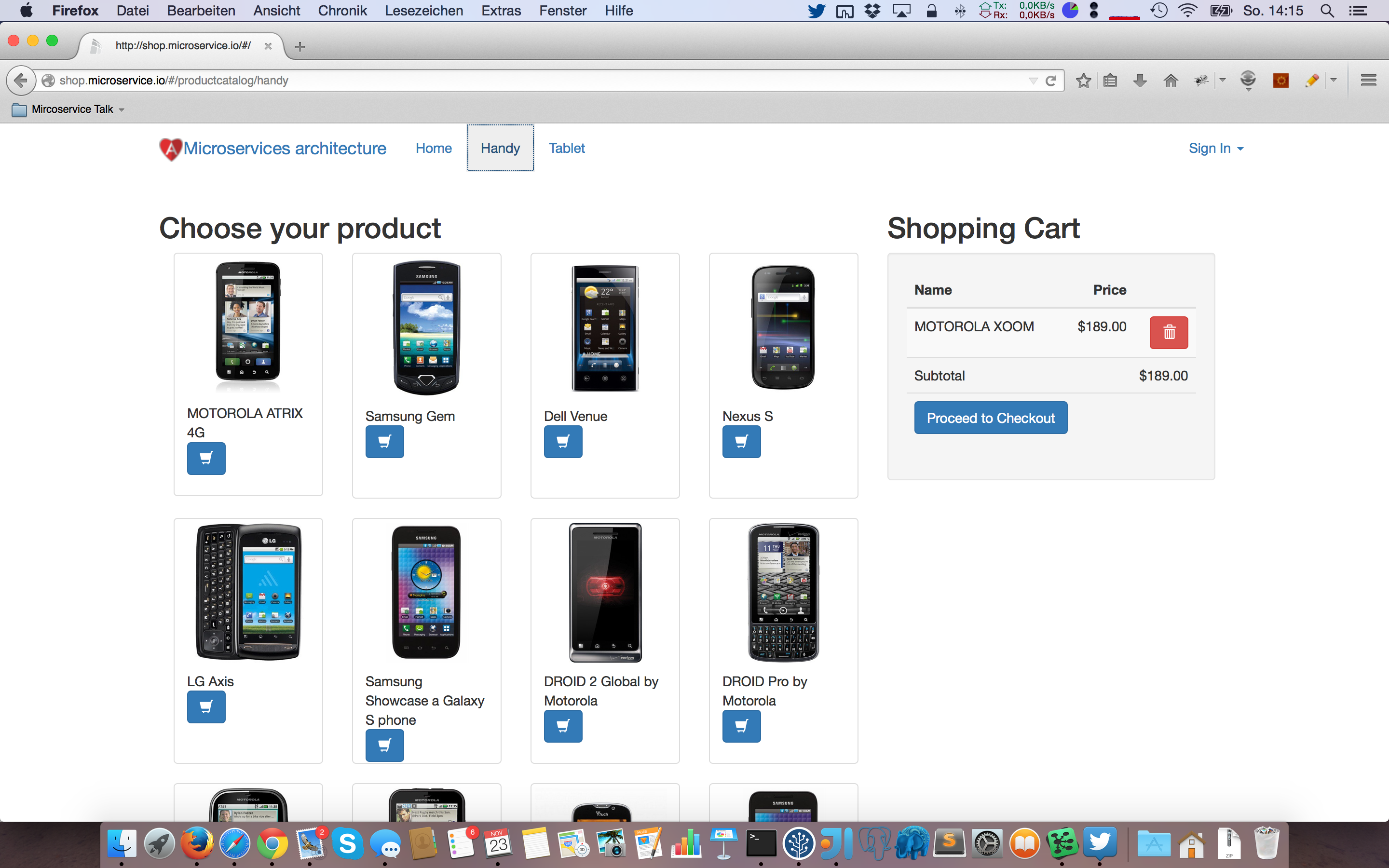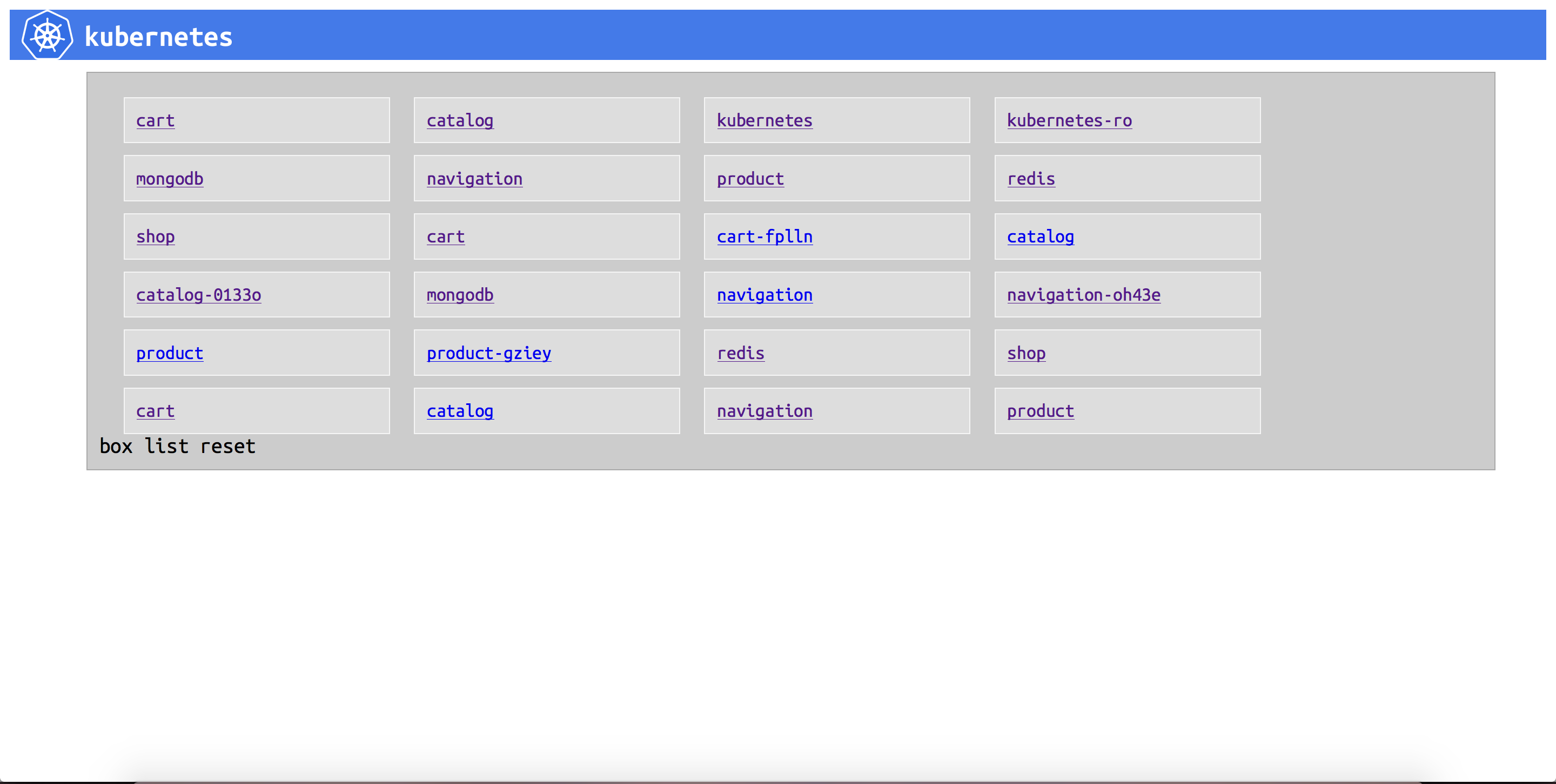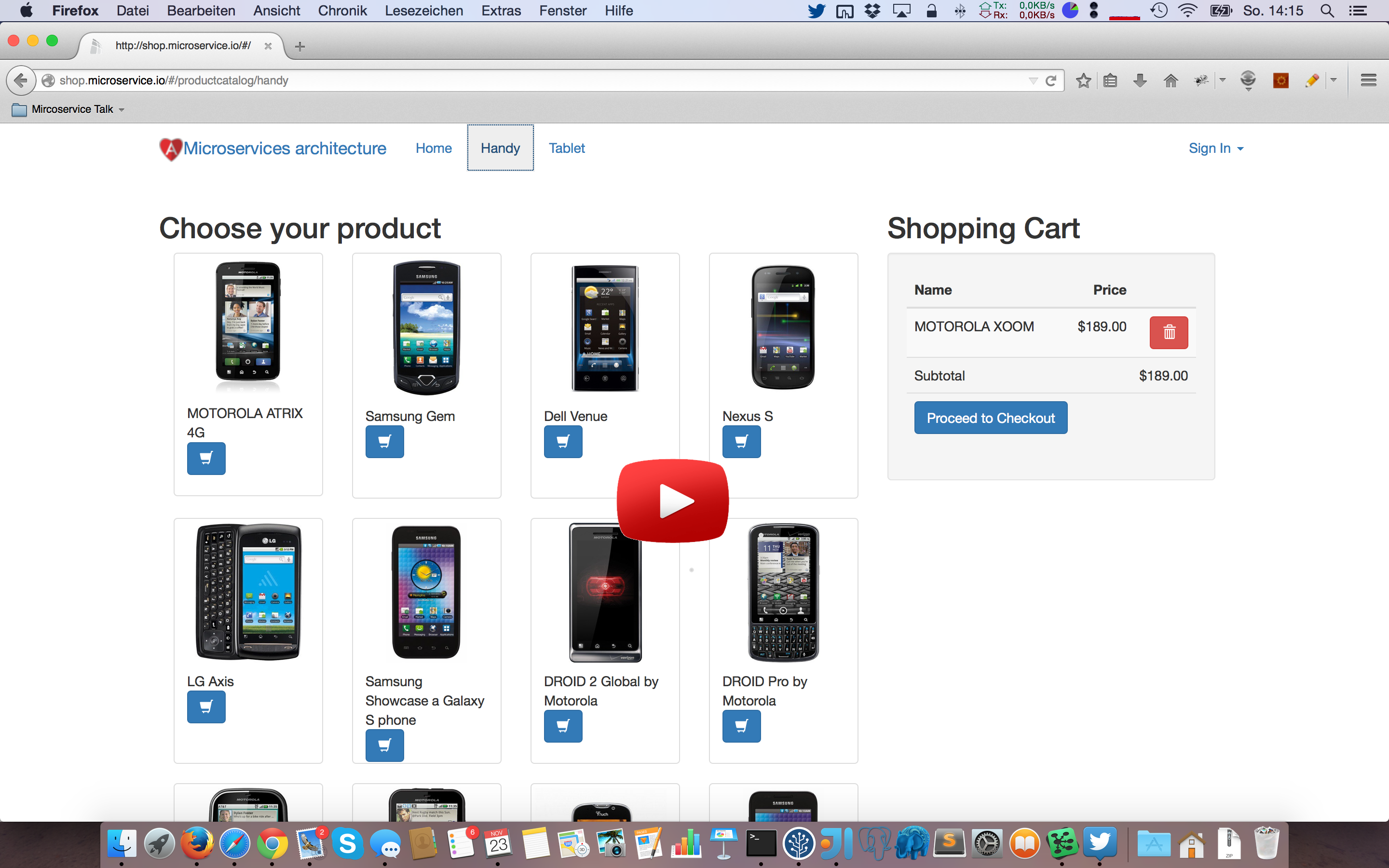This example shows how to run the microservice phone shop application with Kubernetes. Kubernetes is an open source system for managing containerized applications across multiple hosts, providing basic mechanisms for deployment, maintenance, and scaling of applications.
If you want to run the example Microservice Phone Shop Application, you have to install the components which are described in the root readme and the following components:
brew install kubernetes-cli wget fleetctl etcdctl
submodule init
submodule update
Now you should be able to init a Kubernetes cluster. The cluster is based on CoreOS which is
a new Linux distribution that has been rearchitected to provide features needed to run modern infrastructure stacks.
Current Vagrantfile will bootstrap one VM with everything it needs to become a Kubernetes master.
cd vagrant
vagrant up master
Verify that fleet sees it. fleet ties together systemd and etcd
into a distributed init system. Think of it as an extension of systemd that operates at the cluster level instead of the
machine level. This project is very low level and is designed as a foundation for higher order orchestration.
fleetctl list-machines
You should see something like
MACHINE IP METADATA
dd0ee115... 172.17.8.101 role=master
Current Vagrantfile will bootstrap two VMs, by default, with everything needed to have two Kubernetes minions. You can change this by setting the NUM_INSTANCES environment variable (explained below).
NODE_MEM=1536 NODE_CPUS=1 NUM_INSTANCES=3 vagrant up
If everything is init you has to export the following environment variables.
export ETCDCTL_PEERS=http://172.17.8.101:4001
export FLEETCTL_ENDPOINT=http://172.17.8.101:4001
export KUBERNETES_MASTER=http://172.17.8.101:8080
Kubernetes currently supports a simple web user interface.
Start the server:
kubectl proxy --www=$PWD/src/www
The UI should now be running on localhost.
You can use the cluster after a while the cluster should be initialized. If the following command show the same output, our cluster is ready.
kubectl get pods
POD IP CONTAINER(S) IMAGE(S) HOST LABELS STATUS
Now you can deploy the microservice phone shop application. Therefore you has to change to the example/shop folder
and execute the deploy_cluster.sh
cd example/shop
./deploy_cluster.sh
*********************************
Setup Pods
*********************************
redis
cart
mongodb
product
navigation
shop
catalog
*********************************
Setup Replication Controller
*********************************
cart
product
navigation
catalog
*********************************
Setup Services
*********************************
redis
cart
mongodb
product
navigation
shop
catalog
Now it takes a while again, because all docker images has to be loaded from the docker registry. Unfortunately the
cluster is not very chatty. Please the following wikipage
for more information, how to debug the cluster. If pods stay pending, you can use kubectl describe pod podname
for describing the last thing that happened to the pod. Furthermore you can use kubectl get events to see all
cluster events.
kubectl get events
TIME NAME KIND SUBOBJECT REASON SOURCE MESSAGE
Sat, 14 Mar 2015 08:17:51 +0000 mongodb Pod scheduled {scheduler } Successfully assigned mongodb to 172.17.8.102
Sat, 14 Mar 2015 08:17:51 +0000 cart Pod scheduled {scheduler } Successfully assigned cart to 172.17.8.103
Sat, 14 Mar 2015 08:18:03 +0000 cart-fplln BoundPod implicitly required container POD pulled {kubelet 172.17.8.102} Successfully pulled image "kubernetes/pause:latest"
Sat, 14 Mar 2015 08:18:03 +0000 shop BoundPod implicitly required container POD created {kubelet 172.17.8.104} Created with docker id bfeb6e381f537c1f1825331fc9a4dba49baa497fb4d9e105d9c4048e8c69f538
Sat, 14 Mar 2015 08:18:03 +0000 shop BoundPod implicitly required container POD pulled {kubelet 172.17.8.104} Successfully pulled image "kubernetes/pause:latest"
Sat, 14 Mar 2015 08:28:09 +0000 catalog BoundPod spec.containers{catalog} started {kubelet 172.17.8.104} Started with docker id 47b19b30e00d6be63cb9d5f04deb53615bfbc4c25692bd3e12a0af4dc63f9c4c
Sat, 14 Mar 2015 08:28:09 +0000 catalog BoundPod spec.containers{catalog} created {kubelet 172.17.8.104} Created with docker id 47b19b30e00d6be63cb9d5f04deb53615bfbc4c25692bd3e12a0af4dc63f9c4c
kubectl describe pod cart
Name: cart
Image(s): zutherb/cart-service
Host: 172.17.8.103/172.17.8.103
Labels: name=cart,role=service
Status: Running
Replication Controllers: cart (2/2 replicas created)
Events:
Time From SubobjectPath Reason Message
Sat, 14 Mar 2015 08:17:51 +0000 {scheduler } scheduled Successfully assigned cart to 172.17.8.103
Sat, 14 Mar 2015 08:18:03 +0000 {kubelet 172.17.8.103} implicitly required container POD pulled Successfully pulled image "kubernetes/pause:latest"
Sat, 14 Mar 2015 08:18:04 +0000 {kubelet 172.17.8.103} implicitly required container POD created Created with docker id cdf3ec57889e4b3cb9feb76178f7e78fefdfe4e53a033c2808e49abf792b21ad
Sat, 14 Mar 2015 08:18:04 +0000 {kubelet 172.17.8.103} implicitly required container POD started Started with docker id cdf3ec57889e4b3cb9feb76178f7e78fefdfe4e53a033c2808e49abf792b21ad
Sat, 14 Mar 2015 08:33:10 +0000 {kubelet 172.17.8.103} spec.containers{cart} pulled Successfully pulled image "zutherb/cart-service"
Sat, 14 Mar 2015 08:33:10 +0000 {kubelet 172.17.8.103} spec.containers{cart} created Created with docker id 692e0919e4c0da15b685cafcaf3a07addf5855dae9ed3be2ee0367da3ab82026
Sat, 14 Mar 2015 08:33:10 +0000 {kubelet 172.17.8.103} spec.containers{cart} started Started with docker id 692e0919e4c0da15b685cafcaf3a07addf5855dae9ed3be2ee0367da3ab82026
You should see that all pods are running after a while.
kubectl get pods
POD IP CONTAINER(S) IMAGE(S) HOST LABELS STATUS
cart 10.244.102.5 cart zutherb/cart-service 172.17.8.103/172.17.8.103 name=cart,role=service Running
cart-fplln 10.244.5.5 cart zutherb/cart-service 172.17.8.102/172.17.8.102 name=cart,uses=redis Running
catalog 10.244.59.2 catalog zutherb/catalog-frontend 172.17.8.104/172.17.8.104 name=catalog,role=frontend Running
catalog-0133o 10.244.5.3 catalog zutherb/catalog-frontend 172.17.8.102/172.17.8.102 name=catalog,uses=product,navigation,cart,shop Running
mongodb 10.244.5.2 mongodb dockerfile/mongodb 172.17.8.102/172.17.8.102 name=mongodb,role=database Running
navigation 10.244.102.3 navigation zutherb/navigation-service 172.17.8.103/172.17.8.103 name=navigation,role=service Running
navigation-oh43e 10.244.102.2 navigation zutherb/navigation-service 172.17.8.103/172.17.8.103 name=navigation,role=backend,uses=mongodb Running
product 10.244.5.4 product zutherb/product-service 172.17.8.102/172.17.8.102 name=product,role=service Running
product-gziey 10.244.102.4 product zutherb/product-service 172.17.8.103/172.17.8.103 name=product,role=backend,uses=mongodb Running
redis 10.244.59.4 redis dockerfile/redis 172.17.8.104/172.17.8.104 name=redis,role=database Running
shop 10.244.59.3 shop zutherb/monolithic-shop 172.17.8.104/172.17.8.104 name=shop,role=frontend,uses=mongodb,cart Running
Now you can work with the cluster, e.g. you can resize a replication controller or deploy a a/b test.
kubectl resize rc catalog --replicas=3
resized
kubectl get pods
POD IP CONTAINER(S) IMAGE(S) HOST LABELS STATUS
cart 10.244.102.5 cart zutherb/cart-service 172.17.8.103/172.17.8.103 name=cart,role=service Running
cart-fplln 10.244.5.5 cart zutherb/cart-service 172.17.8.102/172.17.8.102 name=cart,uses=redis Running
catalog 10.244.59.2 catalog zutherb/catalog-frontend 172.17.8.104/172.17.8.104 name=catalog,role=frontend Running
catalog-0133o 10.244.5.3 catalog zutherb/catalog-frontend 172.17.8.102/172.17.8.102 name=catalog,uses=product,navigation,cart,shop Running
catalog-ls6k1 10.244.102.6 catalog zutherb/catalog-frontend 172.17.8.103/172.17.8.103 name=catalog,uses=product,navigation,cart,shop Running
mongodb 10.244.5.2 mongodb dockerfile/mongodb 172.17.8.102/172.17.8.102 name=mongodb,role=database Running
navigation 10.244.102.3 navigation zutherb/navigation-service 172.17.8.103/172.17.8.103 name=navigation,role=service Running
navigation-oh43e 10.244.102.2 navigation zutherb/navigation-service 172.17.8.103/172.17.8.103 name=navigation,role=backend,uses=mongodb Running
product 10.244.5.4 product zutherb/product-service 172.17.8.102/172.17.8.102 name=product,role=service Running
product-gziey 10.244.102.4 product zutherb/product-service 172.17.8.103/172.17.8.103 name=product,role=backend,uses=mongodb Running
redis 10.244.59.4 redis dockerfile/redis 172.17.8.104/172.17.8.104 name=redis,role=database Running
shop 10.244.59.3 shop zutherb/monolithic-shop 172.17.8.104/172.17.8.104 name=shop,role=frontend,uses=mongodb,cart Running
kubectl resize rc catalog --replicas=2
resized
kubectl create -f catalog-b.json
catalog-b
kubectl get pods
POD IP CONTAINER(S) IMAGE(S) HOST LABELS STATUS
cart 10.244.102.5 cart zutherb/cart-service 172.17.8.103/172.17.8.103 name=cart,role=service Running
cart-fplln 10.244.5.5 cart zutherb/cart-service 172.17.8.102/172.17.8.102 name=cart,uses=redis Running
catalog-0133o 10.244.5.3 catalog zutherb/catalog-frontend 172.17.8.102/172.17.8.102 name=catalog,uses=product,navigation,cart,shop Running
catalog-b 10.244.59.5 catalog-b zutherb/catalog-frontend 172.17.8.104/172.17.8.104 name=catalog-b,role=frontend Running
catalog-ls6k1 10.244.102.6 catalog zutherb/catalog-frontend 172.17.8.103/172.17.8.103 name=catalog,uses=product,navigation,cart,shop Running
mongodb 10.244.5.2 mongodb dockerfile/mongodb 172.17.8.102/172.17.8.102 name=mongodb,role=database Running
navigation 10.244.102.3 navigation zutherb/navigation-service 172.17.8.103/172.17.8.103 name=navigation,role=service Running
navigation-oh43e 10.244.102.2 navigation zutherb/navigation-service 172.17.8.103/172.17.8.103 name=navigation,role=backend,uses=mongodb Running
product 10.244.5.4 product zutherb/product-service 172.17.8.102/172.17.8.102 name=product,role=service Running
product-gziey 10.244.102.4 product zutherb/product-service 172.17.8.103/172.17.8.103 name=product,role=backend,uses=mongodb Running
redis 10.244.59.4 redis dockerfile/redis 172.17.8.104/172.17.8.104 name=redis,role=database Running
shop 10.244.59.3 shop zutherb/monolithic-shop 172.17.8.104/172.17.8.104 name=shop,role=frontend,uses=mongodb,cart Running
open http://172.17.8.104
You can the the complete example in the following video.
kubectl resize rc catalog --replicas=3
resized
kubectl delete pod catalog-b
catalog-b
kubectl get pods
POD IP CONTAINER(S) IMAGE(S) HOST LABELS STATUS
cart 10.244.102.5 cart zutherb/cart-service 172.17.8.103/172.17.8.103 name=cart,role=service Running
cart-fplln 10.244.5.5 cart zutherb/cart-service 172.17.8.102/172.17.8.102 name=cart,uses=redis Running
catalog-0133o 10.244.5.3 catalog zutherb/catalog-frontend 172.17.8.102/172.17.8.102 name=catalog,uses=product,navigation,cart,shop Running
catalog-hh2gd 10.244.59.6 catalog zutherb/catalog-frontend 172.17.8.104/172.17.8.104 name=catalog,uses=product,navigation,cart,shop Running
catalog-ls6k1 10.244.102.6 catalog zutherb/catalog-frontend 172.17.8.103/172.17.8.103 name=catalog,uses=product,navigation,cart,shop Running
mongodb 10.244.5.2 mongodb dockerfile/mongodb 172.17.8.102/172.17.8.102 name=mongodb,role=database Running
navigation 10.244.102.3 navigation zutherb/navigation-service 172.17.8.103/172.17.8.103 name=navigation,role=service Running
navigation-oh43e 10.244.102.2 navigation zutherb/navigation-service 172.17.8.103/172.17.8.103 name=navigation,role=backend,uses=mongodb Running
product 10.244.5.4 product zutherb/product-service 172.17.8.102/172.17.8.102 name=product,role=service Running
product-gziey 10.244.102.4 product zutherb/product-service 172.17.8.103/172.17.8.103 name=product,role=backend,uses=mongodb Running
redis 10.244.59.4 redis dockerfile/redis 172.17.8.104/172.17.8.104 name=redis,role=database Running
shop 10.244.59.3 shop zutherb/monolithic-shop 172.17.8.104/172.17.8.104 name=shop,role=frontend,uses=mongodb,cart Running
kubectl rollingupdate catalog -f catalog-controller-v2.json --update-period="5s"
Creating catalog-v2
Updating catalog replicas: 2, catalog-v2 replicas: 1
Updating catalog replicas: 1, catalog-v2 replicas: 2
Updating catalog replicas: 0, catalog-v2 replicas: 3
Update succeeded. Deleting catalog
catalog-v2
kubectl rollingupdate catalog-v2 -f catalog-controller.json --update-period="5s"
Creating catalog
Updating catalog-v2 replicas: 2, catalog replicas: 1
Updating catalog-v2 replicas: 1, catalog replicas: 2
Updating catalog-v2 replicas: 0, catalog replicas: 3
Update succeeded. Deleting catalog-v2
catalog
journalctl allows you to filter the output by specific fields. Be aware that if there are many messages to display
or filtering of large time span has to be done, the output of this command can be delayed for quite some time.
journalctl -f -u docker.service
journalctl -f -u kube-apiserver.service
journalctl -f -u kube-controller-manager.service
journalctl -f -u kube-scheduler.service
journalctl -f -u kube-register.service
docker ps -a


